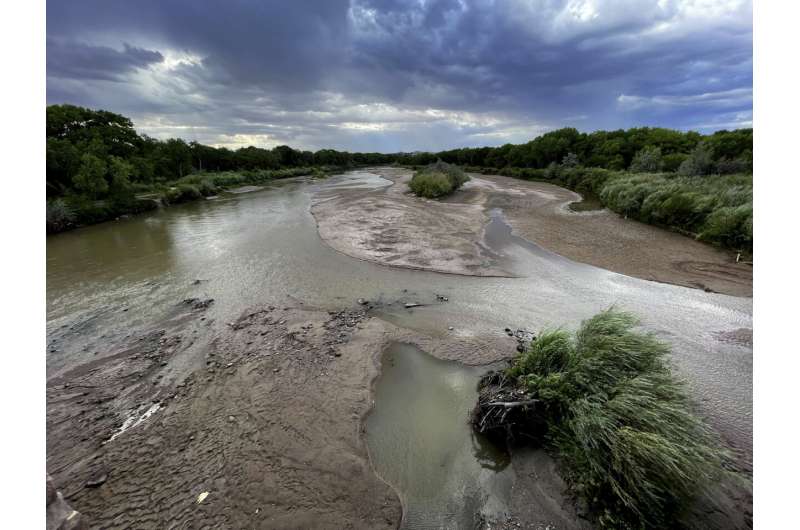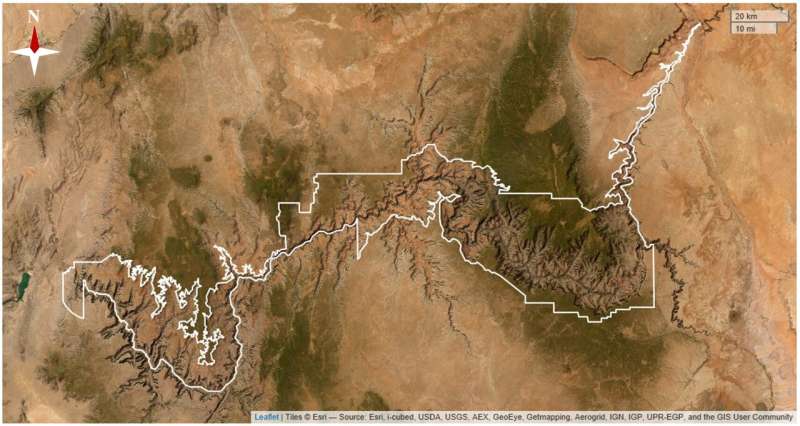Water managers warn that stretches of the Rio Grande will dry up without more rain

The ongoing lack of rain and hot conditions have left one of North America's longest rivers in dire shape again, prompting water managers on Thursday to warn farmers in central New Mexico who depend on the Rio Grande that supplies will be drying up in the coming weeks.
That means stretches of the river through the Albuquerque area are expected to go dry—much like last year.
Water managers and fish biologists at the Middle Rio Grande Conservancy District and the Bureau of Reclamation say they're working to mitigate the effects on the endangered silvery minnow—a shimmery, pinky-sized native fish.
Water users in the Middle Rio Grande have been given notice to anticipate changes in availability and delivery schedules soon.
Due to a higher-than-normal irrigation demand and lower than expected natural river flow, the conservancy district began releasing water on July 17 from the San Juan-Chama Project, which brings water from the Colorado River Basin into the Rio Grande Basin via a system of diversion dams, tunnels, channels and other infrastructure. About 40% of the current irrigation supply is from project storage releases, with the rest from natural river flow.
Irrigation district officials expect water from the project to run out before Aug. 23, leaving them to rely solely on natural flows to continue making water deliveries through the fall.
"The lack of rainfall is difficult on its own, coupled with the challenges of not being able to store water for summer releases, is disheartening, but we are doing our best to work with water users in the middle Rio Grande Valley to deliver what is available," Jason Casuga, the irrigation district's chief executive, said in a statement.
The Bureau of Reclamation will release water to supplement flows in cooperation with the irrigation district and the U.S. Fish and Wildlife Service to target specific areas of the river with known silvery minnow habitat and to manage the rate of anticipated river drying.
The Rio Grande went dry in Albuquerque for the first time in four decades in August 2022 due to persistent drought.
Over the past 20 years, the Bureau of Reclamation has leased about 700,000 acre-feet—or 228 billion gallons—of water to supplement flows through the Middle Rio Grande for endangered and threatened species.
The silvery minnow has been listed as endangered since 1994. It inhabits only about 7% of its historic range and has withstood a century of habitat loss as the nearly 1,900 mile-long (3,058-kilometer) river was dammed, diverted and channeled from Colorado to New Mexico, Texas and northern Mexico.
© 2023 The Associated Press. All rights reserved. This material may not be published, broadcast, rewritten or redistributed without permission.
Models suggest Grand Canyon could see increase in heat-related illnesses due to climate change
A pair of resource stewardship researchers at the U.S. National Park Service's, Natural Resource Stewardship and Science Directorate, working with a colleague from the University of Pennsylvania, has found via modeling that it is likely more visitors to Grand Canyon National Park will experience heat-related injuries as the region warms due to climate change.
In their study, reported in PLOS ONE, Danielle Buttke, Gregor Schuurman and Brinkley Raynor used data from a variety of sources to predict the increase in heat-related illness in the coming years.
Grand Canyon National Park is one of the most visited parks in the U.S. despite its reputation as an extremely hot region. Temperatures at the bottom of the canyon average near 60°C (140°F) during the summer months and can be even hotter on trails leading down because the dark-colored walls absorb heat.
Such temperatures can lead to heat-related illnesses if visitors are not properly prepared—approximately 77 cases of such illness, on average, are reported at the park each year.
In this new effort, the researchers note that as temperatures rise in the area in the coming decades, it is likely that an increasing number of people will experience one or more heat-related symptoms, such as light-headedness, nausea, vomiting, muscle cramps, and in some cases, death.
To predict such an increase, the research team used climate models to predict temperature and humidity increases at the park. They then used statistical models to make predictions about the number of people likely to visit the park in the coming years. Combining the two models allowed them to make predictions about how many people may be at risk of heat-related illnesses up to the end of this century under two scenarios—one where temperatures increase by 3°C and the other where it increases by 5°C.
The team found that unless restrictions are put in place at the park, heat-related illnesses are likely to rise. Under the worst-case scenario, they found that the number of people experiencing such illnesses could rise to between 138 and 254 each year.
More information: Danielle E. Buttke et al, Predicting climate-change induced heat-related illness risk in Grand Canyon National Park visitors, PLOS ONE (2023). DOI: 10.1371/journal.pone.0288812
Journal information: PLoS ONE
© 2023 Science X NetworkIn the summer heat, know how to recognize—and prevent—heat stroke
No comments:
Post a Comment